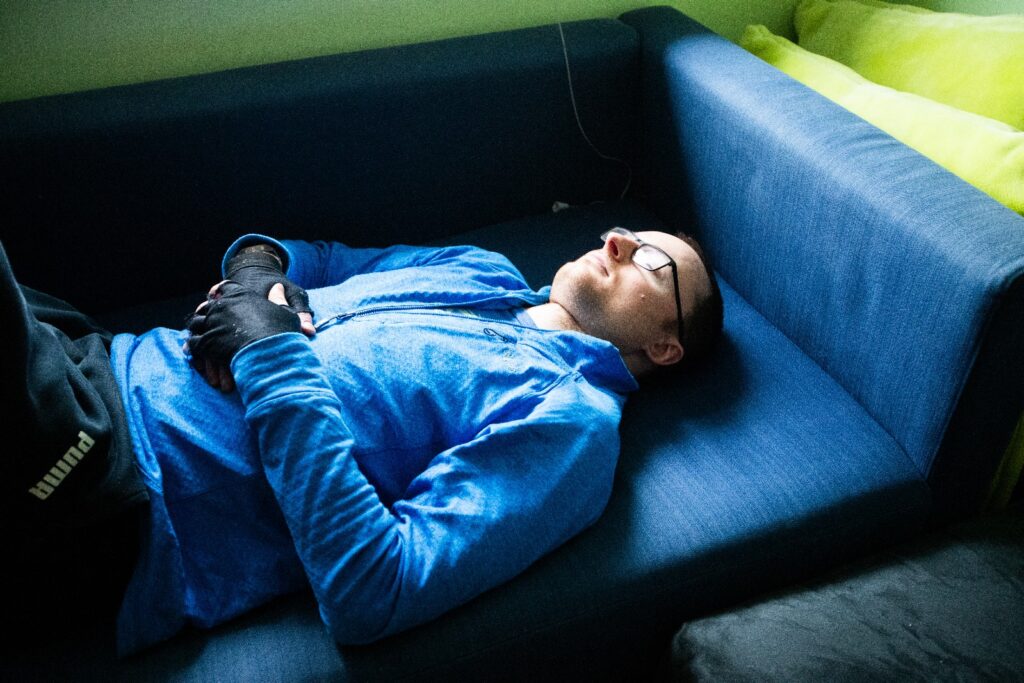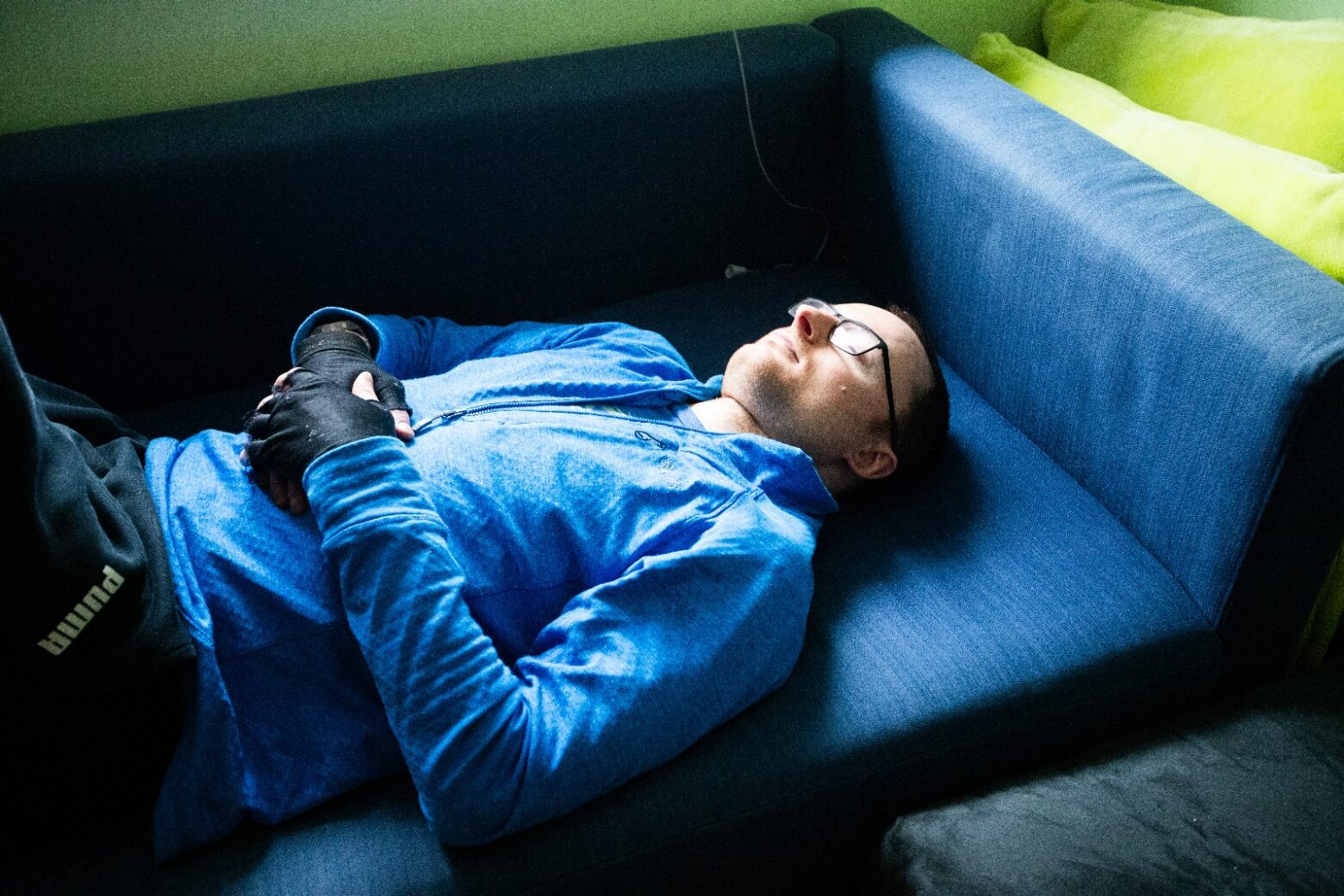This post is a jumbled mixture of how ill I am, and reflecting on the severity and strangeness of the condition.
How Ill I am
I have post-acute covid syndrome (aka long covid). At the moment, I can’t walk out of the house, have a normal conversation, or sit at a table and eat a meal normally. Primarily it seems like it’s a neurological condition, affecting the brain or nervous system’s ability to do various things. I haven’t sweated in over a year, and overheat at anything about 24 degrees.
I spend almost all of my time lying down, as I don’t know how long I can sit safely for. Sitting means that the cardiovascular system has to overcome gravity.
I don’t know exactly how much physical exertion I can do each day, but it isn’t much. I can’t safely be on my feet for more than about 60 seconds, but most of the time I do it in 30 second chunks to be on the safer side. I don’t know how much is safe to do. At the moment my physical activity is limited to going to the bathroom and back, eating food that is given to me, moving things around my room a bit, and brushing my teeth and washing myself in a bath. A couple of months ago I tried going down to the kitchen every day, and it felt fine at the time, but caused a crash on the third and fourth day. I haven’t left the house apart from for medical appointments for a few months, and I attend those using a wheelchair. Soon I’m going to try adding a little bit more physical exertion, such as some additional walks or very light physical therapy.
Mental activity is also limited. Thankfully, I can do more here. I can do a couple of hours of normal-level work each day on my computer, and I can do a few bits of using the computer for social media, writing messages, online shopping, etc, as well. But not much more than that. I can hold conversations, but there’s a limit of around 10 minutes per day I think, and the conversation can’t have much complexity. The rest of the time, I listen to audiobooks or light television at 0.75 speed — easy fiction or light entertainment. Most TV shows are too much for me, it has to be slower paced stuff, like nature or travel shows, and not contemporary things aimed at people with short attention spans.
So… it’s pretty limited.

On it being strange
It’s a funny thing, when people get in touch, and I have to update them with the fact that I am ill. Or even people who already know that I’m ill. It happens that I say I’m very ill, and people don’t grasp the severity of it. For example, people offer a phonecall (which I can’t do), or message to say they hope I’m enjoying the weather (I don’t go outside). [Of course some people to grasp the severity, or say that ‘if you’re up for it’ we could have a phonecall, or similar.]
I think it comes down to that I’m ill in a way that simply doesn’t fit into how many people understand the world. It’s not part of people’s worldview that I’m not well enough to walk out of the house, or hold a conversation.
I think this is a mixture of things. Part of this is just, we mostly live our lives not thinking about the fragile possibilities. We generally don’t have it in our minds that people we know might suddenly die, or that the next time we see them they might be in a wheelchair, or experience a mental breakdown. Partly is a lack of awareness of conditions — there are all number of health conditions that aren’t widely understood (and we can’t be encyclopaedias). I found this too when I suddenly developed a batch of food intolerances, not something I had previously known much about, and I had to explain to people all these random foods that I can’t eat.
And part of it is also that post-covid syndrome and chronic fatigue are just quite strange health conditions. Sometimes I also feel like it doesn’t make sense, and if I wasn’t experiencing it, and had an empirical record of it, I wouldn’t believe it either.
People also see me usually at my best, not my worst; fluctuating and chronic health conditions are like this. Visitors will see me talking with energy, instead of lying in a dark room doing little. I remember a time last year when I went to a cafe to meet some friends for brunch. This was before my most recent relapse, when I had been quite ill but had recovered some way. Going to the cafe was the most exertion thing I had done for a few days — travelling, walking, spending an hour talking — and then they invited me to play some games after. “You don’t have to play, you can just relax in the room.” They didn’t see that me coming to the cafe for an hour was already my limit and risky, and that travelling to their house and even being around other people would be too much.
People also ask, Oh, what has the doctor said? The GP doesn’t know. I’ve seen three and all knew less than me. This isn’t a well known condition — absurd given how widespread the pandemic is. Many GPs don’t even recognise it, and many with the condition have specialists dismissing it all as anxiety or depression or being unifit, though I think there is a lot more knowledge about it this year than last. There is no good treatment available; hopefully there will be in the next 5 years or so. It’s a condition that can’t be cured at the moment, and treatment is just about management. I’ve been seen by three specialist post-covid clinics; two of them were useless, the third was actually knowledgeable (but there isn’t much they can do).
Background Information about PACS
Some background about the condition. One of the difficulties with post-acute covid syndrome* (PACS, aka long covid, post-acute sequelae of COVID-19, post-covid syndrome) is that there is an invisible and unknown limit of how much you can do. Part of this is that you there is a strange lag on feeling the effects, so there’s a zone where you have overdone it but don’t know until the next day, or the day after — though if you overdo it too much then you do feel it at the time.
*Though the condition includes many related sub-conditions. Here I am talking primarily about the fatigue and autonomic nervous system dysfunction which includes problems with mitochondrial dysfunction, blood vessels not working properly, and acute ANS dysfunction.
This is not only physical exertion but also mental and emotional exertion and stress. The biological cause of this limit, I’m not sure is known yet. There are only so many steps you can take in a day, only so much thinking energy available, so much stress your body can tolerate. Usually, by the time we know we’ve crossed the line, it’s already too late. Were I to exercise, by the time I start to feel tired, my cells running out of energy, I’ve already overdone it – whatever is going on with mitochondrial dysfunction means that there will be problems. I have had times where I felt totally fine during the exercise (eg walking) and afterwards seemed totally fine, but it turned out the next day I had overdone it. Sometimes we can feel bad immediately afterwards, but the ‘post-exertional malaise’ effect typically hits 12-36 hours afterwards.
Overdoing it causes a ‘crash’ of some variety, either immediately or with the 12-36 hour time lag. This can involve a range of symptoms. Usually, the autonomic nervous system gets into a stressed state, there is fatigue, headaches, and negative emotions. In the short-term, it’s unpleasant. But in the medium and long term, it means that one’s general condition can get worse. Living in a boom-and-bust cycle of overdoing it, paying the price for 1-3 days, recovering, then going again, means that one can get worse over time – as has happened to me a few times. It’s not like a food intolerance, where you could eat pizza and ice cream if you really wanted and pay for it for a couple of days with no risk of any problems beyond that. It is not a condition where pushing through makes any sense.
The big danger is becoming bedbound. If someone keeps getting worse, their thresholds can fall so low that even the daily basics are too much: walking to the toilet, washing, basic brain activity and communication, eating and digesting can all be a problem. People get stuck here because basic survival involves a biological deficit which cannot be escaped – like a gravity well or trying to empty out a boat with a leak. There are examples of people like this online, if you would like to look for it. The science communicator Dianna Cowern, YouTube channel ‘Physics Girl’, is one example with documentation.
This isn’t new with Covid-19 either: ME/CFS and post-viral fatigue has been around for a long time. A friend who studied the Spanish Flu told me that the same thing happened to many people after that pandemic, with many being sent to live in asylums.
There’s also the risk of being ill enough that while not bedbound, independent living and earning enough money to live off isn’t possible. Avoiding this was my priority: ensuring that my health is always trending in a positive direction has been vital.
The condition is still not well understood. Many of the pathologies are known and being researched: the ANS doesn’t work properly, which impairs blood flow around the body; mitochondria in the cells don’t function properly, limiting energy production; blood vessels are damaged and inflamed, impairing the micro-level exchange with cells; the body or particular areas become inflamed; there can be autoimmune responses; and more. Why exactly this happens, I don’t know, and I don’t think researchers have discovered yet. There are a few theories going, but none seem to fully explain or cover all of the issues. But, for whatever reason, when we do too much, it gets into a negative cycle where blood vessels are impaired, mitochondria are damaged and dysfunctional, and the ANS is dysregulated and more fragile. We feel fatigued, stressed, headaches, etc, because, biologically, basic bodily functions are not working properly.
Managing the condition is about figuring out a version of ‘pacing’ – working out what can safely be done each day without crashing. I have a pretty consistent routine and structure which hopefully allows me to do a safe amount of activity without doing too much. As well as avoiding crashes and getting more ill, it means that the body can stay in a restful state and (hopefully) undergo a healing process.
